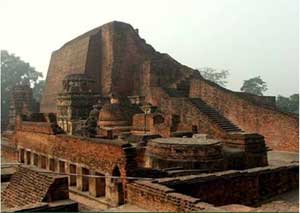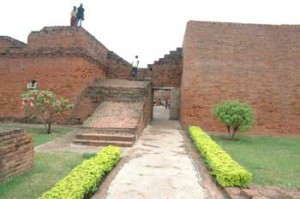
Not many studies have been conducted on the function of the Muarajambi complex and its historical context. Although a number of international and domestic experts have analyzed its architectures and artifacts found in the area, however, there have not been any satisfactory explanations. Some experts limited their conclusion that Muarajambi complex was a place for worship.
In order to understand Muarajambi region in its entirety, especially since it took place many centuries ago, it is necessary to comprehend the matter from a contextual point of view. Descriptions or nuances from comparable learning centers from the same period of time may help to provide some clues. Thus, let us review Nalanda university.
Nalanda University
The site of Nalanda university is located in the Bihar province of India. Nalanda was established in the 5th CE by the kings of the Gupta dynasty. Equipped with dormitories, Nalanda was the one of the first residential university in the world, where students from China, Korea, Sri Lanka and Indonesia as well as various regions from India came to study. During its heydays, Nalanda had over 10,000 students and 2,000 teachers. Nalanda as one of the world’s oldest learning centers lasted until the 12th CE.
Nalanda’s Development
The development of Nalanda Mahavihara university reflects the evolution of cultural changes and the shift in purposes of Indian monasteries at the time. This change began in the era of the Gupta dynasty during the 5th CE, with the establishments of Mahaviharas, which are groups of a number of smaller viharas.
Traditionally, learning in monasteries was a sheltered pursuit, limited to monks studying religious lore relating to monkhood. The aim of monastic learning was to produce the “perfect monk”. Monks learned Buddhist canon and philosophy, from a master presiding over a small group of pupils. However, it soon became clear that an understanding of secular subjects and the wider world outside the monastery (including other faiths) was needed. An inward-looking approach focused purely on the “study for faith” would not provide the knowledge nor the intellectual skills to be the “perfect monk”. In order to be the “perfect monk”, the scriptures advise the monks to: “… bahujana hitaya bahujana sukhaya lokanukampaya …”, which means “ … for the benefit of many, for the happiness of many, out of compassion in the world …”. An insular approach would also prevent monasteries from properly fulfilling their core aim of serving others in the wider community. For example, one of the attributes of the “perfect monk” is the capacity to teach Dharma among lay people and the ability to recognize and question teachings from other traditions.
It should also be noted that these transformations occurred during a period of decline in Buddhism throughout India. It was against this background that the Mahayana school was formed (in the early CE centuries). The Mahayana school adopted this liberal and multidisciplinary learning approach. Nalanda university was established under the Mahayana tradition even though teachings from all other schools were also studied. Sanskrit was then the medium of instruction in liberal studies all over India.
Nalanda developed from a Mahavihara into a university and operated as such for many centuries. Its strong reputation (which peaked in the 7th Century) was reflected by the number of foreign monk-scholars eager to attend Nalanda for further studies, including those from China, Indonesia, Tibet and Korea. It is the records of these Chinese and Korean monk-scholars that provide the only information on life and activities at Nalanda.
Many Nalanda’s alumni held important roles in the development of Buddhist Mahayana philosophy, among others are Acharya Nagarjuna, Aryadeva, Buddhapalita, Bhavaviveka, Chandrakirti. It was these famous Mahayana teachers who composed many treatises and commentaries.
Study for Knowledge
As monasteries shifted their learning focus from a “study for faith” to a “study for knowledge”, this resulted in a number of changes including:
- Monasteries in India that were previously meant only for monks developed into learning centers that were also open to lay people. Lay students were allowed to reside at the monastery to study either Buddhist literature or purely secular subjects. No charges were applied for studying and staying in the monastery.
- The spectrum of subjects were expanded to include principally:
- 1. Teachings on the Mahayana view and teaching from the other 18 philosophical schools of thought (Hinayana);
2. Other teachings such as Veda and other secular teachings;
3. Pancavidya (five sciences), namely: (a) logic (hetuvidya), (b) grammar and philology (sabdavidya), (c) medicine (cikitsavidya), (d) arts (silpasthanavidya), and (e) metaphysics and philosophy (adhyatmavidya).
Academic and Social Life in Nalanda
Nalanda, being a seat of higher learning, had a specialization system. Beside formal instruction given by teachers, there were ‘schools of studies’ or ‘schools of discussions’, implying that it was the regular practice to throw open the subject taught for discussion and investigation from different angles and standpoints.
According to Hwui-Li, about 100 pulpits were set up daily to deliver classes, evidently in different ‘schools’, and that ‘the students attended them without any fail even for a minute’. If the total number of students was approximately 3,000, therefore each class must have been attended by a class of about 30 students.
The routine of daily life was mainly divided between study and religious rites. The hours of worship and holding of classes were regulated by water clocks or sound of a bell. A row of monasteries and a row of temples (caityas) run parallel with a stretch of bare ground in between. Presumably the inhabitants crossed this ground to go from monastery to temple. Once the prayers and rites were performed, the rest of the day was given to studies and discussion, the inhabitants meeting at stated hours for lectures in separate groups in the different ‘schools’.
There was no united congregational worship for all the residents. For reasons of practical convenience, worship took place separately and they were held in different halls. There were eight halls and a number of caityas in Nalanda that were used for worship.
No community kitchen or common dining-room can be traced among the ruins, but there are only a few open ovens scattered here and there in the courtyards where snacks or merely small quantities of food could be cooked. According to the Vinaya and Indian traditional customs, the whole monastery can be regarded as a monastic kitchen, but to take a part of it to be used as a kitchen is also allowed. It seems that food used to be prepared in a closet or compartment within the monastery and taken by the monks to their own rooms and eaten there.
Toilets could not be found in Nalanda. The lack of toilets seems to suggest either the Indian practice of defecation at a secluded spot out in the fields or that there were trench-latrines. Bathrooms were not provided, though there is a set of rooms with a central water-reservoir and a stone slab at the opening of each cell for thrashing dirt out of wet clothes.
Apparently, residents of Nalanda were very organized with regard to their bathing time. A time in the morning was appointed for all residents to go out for a bath and was announced by striking a bell. The inhabitants would move out of their rooms, each with a bathing suit, for the open-air bath, as written by I-Tsing “Sometimes a hundred, sometimes a thousand, leave the monastery and proceed in all directions to these ponds, where all of them take a bath”. There were ten big ponds in the Nalanda campus.
Attendance List
As was customary among the better Indian monasteries, Nalanda maintained a list of its inhabitants. In addition, Nalanda operated under a strict set of the rules and regulations, violation of which lead to expulsion.
There were many students applying to study at Nalanda, as attending the university was very prestigious. To cope with the rush for admission to Nalanda, tough admission criteria were introduced, including passing a rigorous entrance exam. Out of every 10 applicants, there would typically be at least 7 or 8 who failed. Hence, the seat of learning in Muarajambi that served as a place to study before going to Nalanda assumed an important role. I-Tsing wrote, “If a Chinese monk wishes to go to the West in order to hear (lectures) and read (the original) scriptures, he had better stay here one or two years and practice the proper rules and then only proceed to Central India”.
Period of Study
Nalanda did not appear to set a fixed period for which students could stay. It was determined perhaps by the time taken by the student to complete his study of the subjects selected. As an example, Hsuan-Tsang and I-Tsing, who were already established scholars when they attended, stayed for 6 and 10 years respectively.
University of Nalanda Mahavihara
It was king Sakraditya of the Gupta dynasty, also known as Kumaragupta I or Mahadraditya, who initiated the construction of Nalanda university. Sakraditya reigned from 415-455 CE. Later, other kings from the same dynasty, namely Buddhagupta, Tathagatagupta, Baladitya and Vajra also built monasteries around the original building as follows:
- Buddhagupta (son or grandson of Sakraditya) built a monastery to the south of the original monastery;
- Tathagatagupta built a monastery to the east of Buddhagupta’s monastery;
- Baladitya built a three-storeyed pavilion (temple and monastery combine);
- Vajra built a monastery to the west of Baladitya’s.
Chinese records note that after Vajra’s time, another king, Yasodharmadeva built another monastery to the north of Vajra’s monastery and, importantly, also built a high wall enclosing all of the monasteries. These disparate monasteries were then combined into one Mahavihara in about the 6th CE, as evidenced by an official seal of the new “Nalanda Mahavihara”.
As previously mentioned, Nalanda university initially started as a mahavihara, and subsequently all the monasteries were then built one after the other at different time periods. It took approximately 110 years to complete all the five monasteries. All the buildings were built next to each other, forming a row.
The contributions of these kings were magnificent. I-Tsing reports that the land held by Nalanda contained more than 200 villages and had been bestowed by the Gupta kings. It is a very interesting fact that kings of the Gupta dynasty were not Buddhists, but Brahmanist. Most probably, the support and contributions extended by the kings are not based on religious grounds, but was more intended to foster and develop an education systems and culture for the benefit of its people at large.
 Bahasa
Bahasa
 October 24th, 2010
October 24th, 2010  SUDIMUJA
SUDIMUJA 
 Posted in
Posted in  Tags:
Tags: